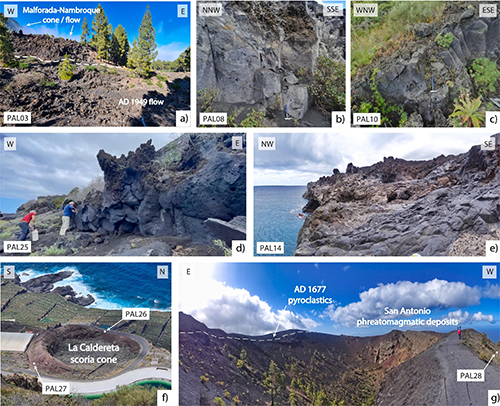Age-clustered eruptive activity at La Palma (Canary Islands) during the last 4000 years: Evidence from paleomagnetic dating

Magli A., P. Del Carlo, A. Di Roberto, G. Giordano, S. Meletlidis, M. Pompilio, F. Speranza, (2025).
Journal of Volcanology and Geothermal Research, https://doi.org/10.1016/j.jvolgeores.2025.108328
Abstract
The detailed knowledge of timing and dynamics of pre-historic eruptions is pivotal for volcanic hazard assessment. This is most relevant for inhabited lower slopes of active basaltic volcanoes such as La Palma (Canary Islands), where the 2021 Tajogaite eruption caused severe destruction. We paleomagnetically investigated eight La Palma Holocene eruptions which are currently loosely constrained either by few radiometric (K/Ar and 14C) ages, or by stratigraphic/archaeological evidence. The paleomagnetic directions gathered from 28 sites (300 oriented cores) were compared with updated reference models of the paleo-secular variation of the geomagnetic field direction during the Holocene. Overlapping paleomagnetic directions from the Fuego and La Fajana lava flows, along with geologic and geochemical evidence, imply that the two flows were emplaced during the same eruptive event falling within the 2000–1730 BC time window. Single paleomagnetic age windows – consistent with and narrower than available 14C age intervals – were obtained for the Malforada–Nambroque, Montaña Quemada, and Fuego–La Fajana lava flows. Conversely, the Martín, Birigoyo–La Barquita, and La Caldereta flows yielded multiple age solutions. Moreover, our data show that the flanks of the pre-historic San Antonio scoria cone are almost totally covered by pyroclastic products of the nearby AD 1677 Fuencaliente eruption. The updated chronologic framework of the pre-historic volcanic activity at La Palma demonstrates that the past four kyr are characterized by an early period with low-frequency eruptions (three lava flow eruptions between ca. 2000 BC and 300 BC), followed by a ca. 1000 yr-long quiescence period, and by a subsequent clustering of nine events during the last 1100 yr (about one eruption per century).



Devi effettuare l'accesso per postare un commento.